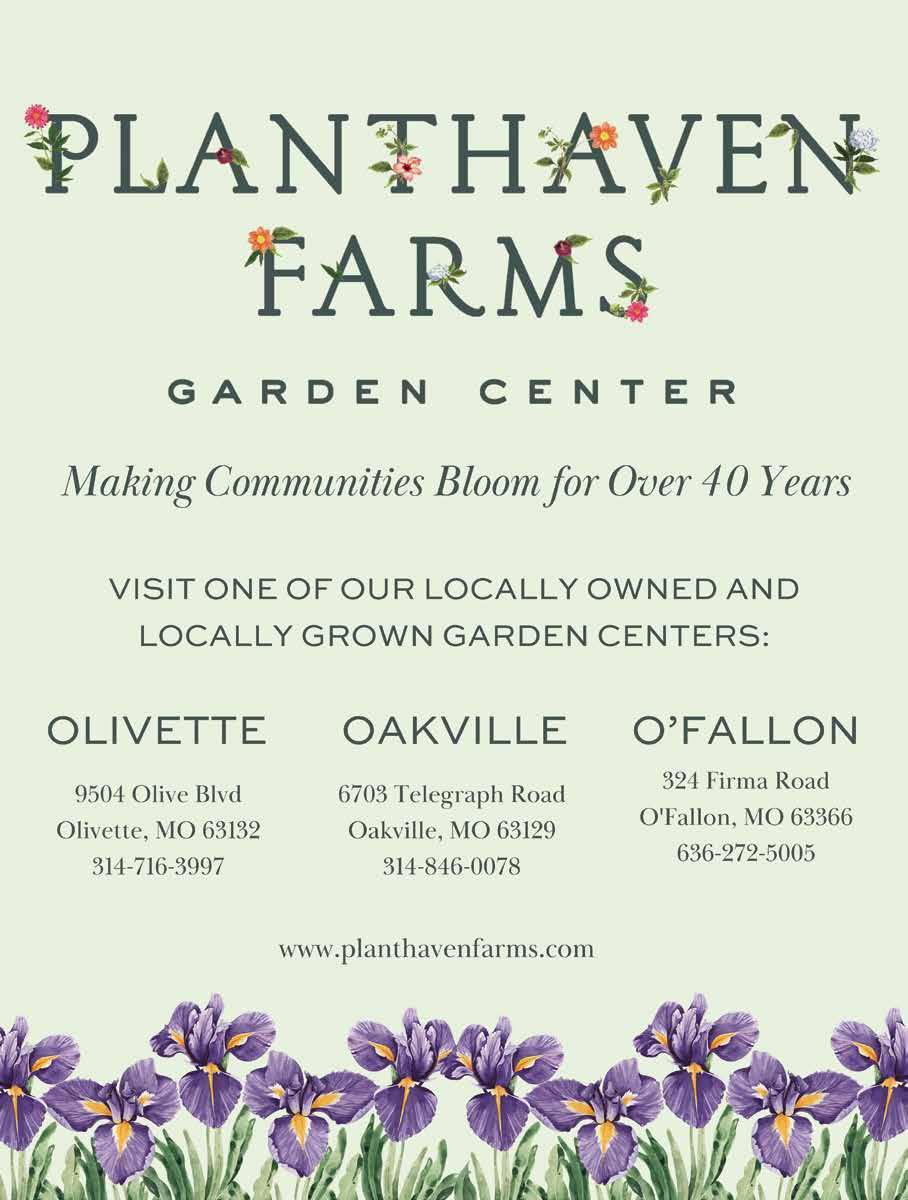








Because ferti•lome® is dedicated to making products that allow everyone to feel good about their lawn and garden choices, we are continuing to expand our natural and organic product line.

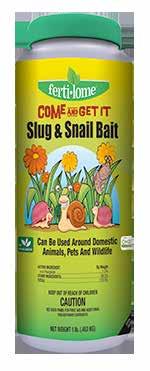



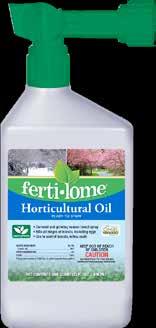
Joyce Bruno & Robert Weaver
Publisher and Editor
Robert Weaver
Columnists
Abby Lapides
Sugar Creek Gardens
Steffie Littlefield
Edg-Clif Winery
Scott Woodbury
Cacalia Native Garden Design and Wilding
Samantha Zale
Greenscape Gardens
Printing: Breese Publishing, Breese, IL
The Gateway Gardener® is published 7 times/year by Double Dig Communications, Inc. to promote enjoyable, successful gardening and livable landscapes in the St. Louis greater metropolitan area. The magazine is distributed free to the public at designated garden centers, nurseries, garden gift shops, lawn equipment rental, repair and sales establishments, and other locations supporting sound gardening, lawn and landscaping practices.
Please send letters-to-the-editor, questions, event announcements, editorial suggestions and contributions, photos, advertising inquiries and materials, and any other correspondence to:
The Gateway Gardener Magazine® PO Box 220853
St. Louis, MO 63122 Phone: (314) 968-3740
info@gatewaygardener.com www.gatewaygardener.com
efore I started publishing this magazine 20 years ago, I was the communications manager for Schultz Company, the horticultural manufacturer best known for its dropper bottle liquid plant food (“7 Drops Every time You Water”). In addition to writing all their marketing and public relations materials, I was also assigned the task of answering customers product and plant care questions. They had a sister product to the generalpurpose plant food labeled specifically for African violets, and so many of the questions that came my way were about those very popular houseplants. (Want to know what to do when your African violets grow “long necks”? I can tell you!) Since those days, I’ve not given much thought to African violets. So, it took me happily back in time to see Samantha Zale offer up her article on them just in time for Mother’s Day. Check it out on page 12.
Vegetable gardeners will notice the absence of Steffie Littlefield’s regular article on growing edibles. Steffie’s family homestead and business, Edg-Clif Vinyard, Winery and Brewery, in Potosi, Missouri,

took a severe hit in the spring tornadoes that swept through Missouri. Fortunately, no one was injured and the grape vines were not seriously damaged. But several structures were damaged, so we gave Steffie this issue off to focus her efforts on putting Edg-Clif back together again, and we look forward to her return as soon as possible.
Several familiar voices stepped in to fill the void. We’re pleased that Margy Terpstra returned for a birding encore to update us on the busy migration season as seen from her Kirkwood bird haven. See her beautiful pictures and commentary on page 14. Master Gardener and insect specialist Ronda Anson stepped in to educate readers on the differences between squash
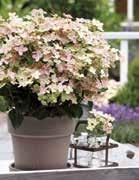





bugs and squash vine borers, and how to treat each. See page 17. And arborist Wendell Phillips Berwick of Living Tree Care took on a topic worrying many homeowners: galls on oak trees. Find out more on page 11.
Our regulars, Abby Lapides and Scott Woodbury, put us back on a more positive track. Abby takes a look on page 4 at some small plants that produce big rewards in gardens and containers, while Scott explores what rewilding our landscapes can do—even on a small scale—for creatures and the environment. See page 8.
Finally, it’s Garden Tour season, so get out your calendars and save the dates in our previews on page 18. Happy Mother’s Day! And… Good Gardening!

By Abby Lapides


YOUR ONE-STOP-SHOP FOR
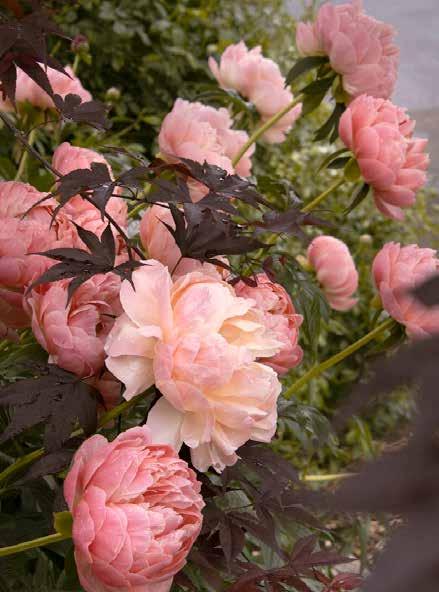

Great things often come in small packages. Discover some captivating small plants that deliver stunning displays.
A tiny, adorable daisy, ‘Sweet Daisy Shelly’, Leucanthemum, provides an abundance of quarter-sized flowers on tight mounded foliage. Small frilled white petals surround golden yellow centers. This long blooming and hardy plant will bring joy to the front of the garden or in containers. While the flowers are so tidy they look unreal, this little powerhouse will be loaded with pollinators all summer long.


‘Sweet Daisy Shelly’
‘Little Rockstars Red’ butterfly bush, Buddleia, plant is perfectly adorned with hordes of beautiful cone-shaped red blooms. The rosy-red blossoms are so perfectly arranged that you’ll wonder if some magical floral arranger placed them. ‘Little Rockstar Red’ only grows to 1’ tall, an ideal size for the front of the border or as tiny hedge.

‘Nova Blue’ catmint, Nepeta, produces gorgeous lavender purple blossoms over a long time on a short 4’ plant. Masses of flowers appear from late spring into fall. Tolerant of considerable drought, it flourishes in full sun to partial shade and well-drained soil. It attracts bees, butterflies, and hummingbirds. Its aromatic foliage stays tidy all season and is deer and rabbit resistant.

You’ll be dancing with joy when you experience the fun that the perennial ‘Pop Star Blue’ balloon flower, Platycodon, brings to the garden. This superstar features flower buds that swell into plump balloon-like orbs and then pop open to reveal huge star-shaped violet-blue blossoms. It has a very compact habit, growing only 6-8” tall and 10-12” wide. Long blooming, you can expect to see its entertaining blossoms throughout summer. This native three-leaved stonecrop, Sedum tertatum, makes a natural ground cover in sunny to part sun sites. It spreads by creeping stems that root at the nodes. Its fleshy leaves appear in whorls of three. Pretty starry clusters of tiny white flowers with purplish stamens appear in spring. A tough plant that holds up to cont’d. on next page
Abby Lapides is owner and a speaker at Sugar Creek Gardens Nursery. She has degrees from the University of Missouri, and is a member of the Landscape and Nursery Association of Greater St. Louis. You can reach her at (314) 965-3070.



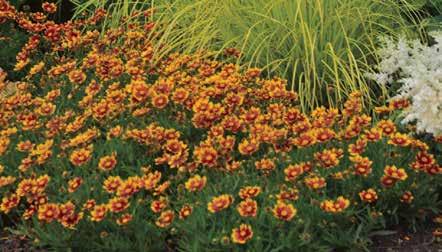

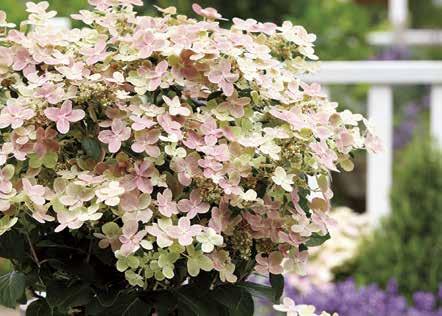
rabbits, deer, drought, and air pollution. Three-leaved stonecrop will grow in more shade and moisture than many other sedums. Only grows 4-6” tall.
‘Daybreak’ tickseed, Coreopsis, produces a shower of cheerful bi-color blossoms with a prominent orange-red center and fringed, gold petal tips from early summer through early fall. Being sterile, flowers keep on coming all season long without the need for deadheading. It forms a compact mound of highly disease-resistant, dark-green foliage. It is a fantastic plant that can replace annuals in gardens and containers. Part of the Li’l Bang series of tickseed that are prized for large stunning flowers, tidy habits, long bloom time, and disease resistance.
One of the smallest panicle hydrangeas available, ‘Early Evolution’, adds large pops of flowers on teeny shrubs. Flowers begin to appear in early June, with the creamy white flowers appearing in large clusters. As flowers mature, they take on a dusty rose-pink color and transform into salmon pink in fall. The flowers appear on the shrubs for months. The flowers dry right on the shrub, bringing considerable interest to the winter landscape. Growing only about 2’tall and wide, Early Evolution may be used to create small hedges, particularly lining a walkway or patio. It is also a choice plant for where small, long-blooming accents are needed.




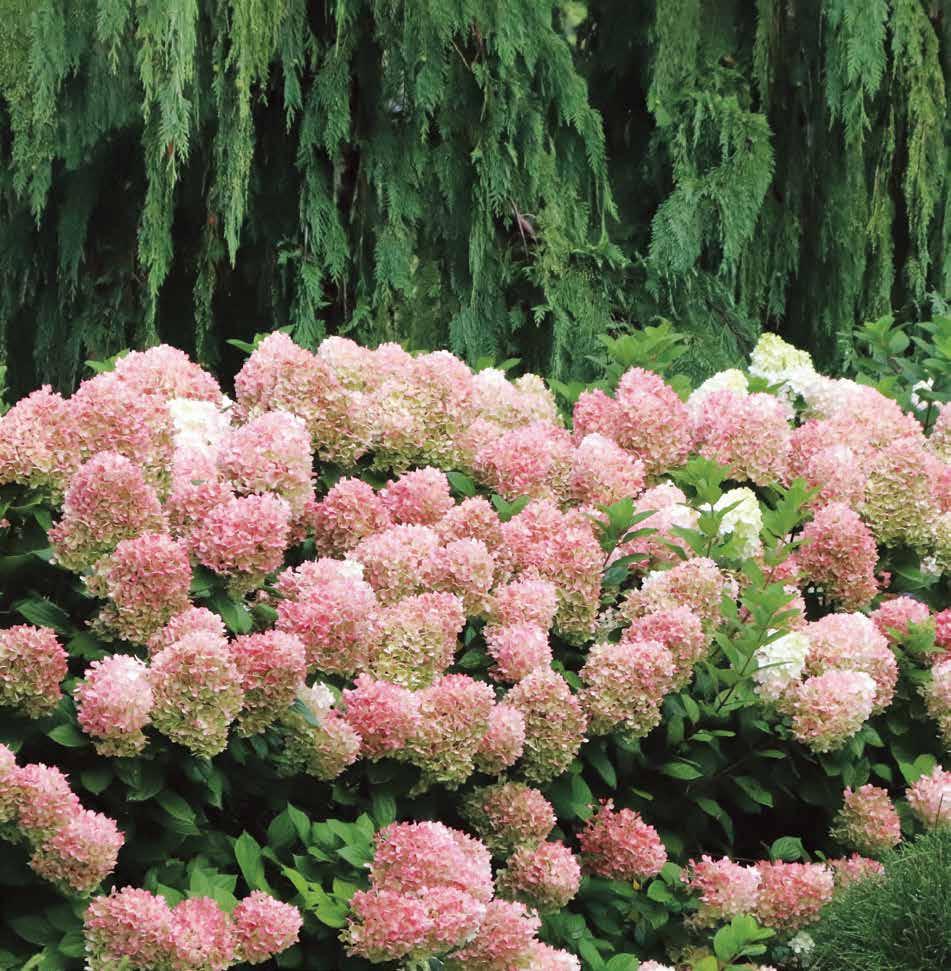































by Scott Woodbury


Rewilding: an effort to increase biodiversity and restore the natural processes of an ecosystem.
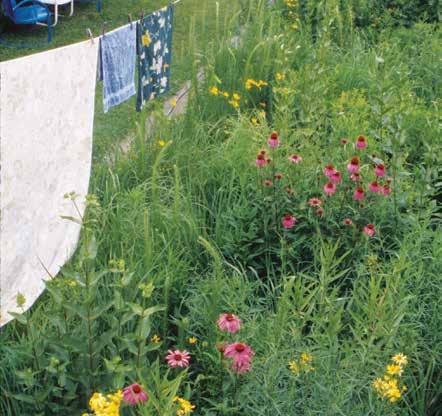
The rewilding movement currently afoot in Great Britain is an exercise in letting go of conventional farming and landscaping techniques that have been chugging away unchallenged for centuries.
Trusted and organized methods of row-cropping and animal husbandry are being left (by a few) to rust in the field, in favor of free-ranging animals and plants that have broken free from restrictive pens and hedges. Pigs are allowed to root through fields and even front lawns, and the soil they stir up sprouts new seedlings dispersed by wind, water, birds, and mammals. Brush-eating livestock keep the land open by preventing many trees and shrubs from dominating the landscape. Shrubs spread from hedgerows and gardens, taking on organic shapes across the landscape in response to elevation, contour, and soil moisture patterns, rather than straight lines from a farmer ’s seeder or a designer ’s pen.
In other words, plants, especially native plants, are migrating from cultivation and are finding the right places to thrive in nature, all on their own. You know the saying—right plant, right place— only those decisions aren’t entirely human choices anymore.

Scott Woodbury was the horticulturist at Shaw Nature Reserve for 30 years and stepped down from that position in June 2022. He continues to work on contract for Shaw Nature Reserve to carry out native landscaping education, and has launched his own business called Cacalia: Native Garden Design and Wilding. Scott is also founder of the Wild Ones St. Louis Chapter, which financially supports this column. Find suppliers of native plants, seeds, and services at the Grow Native! Resource Guide: www.moprairie.org.

An example of how even tiny slices or urban ground can be rewilded to the benefit of pollinators and people.
With rewilding, design (if you can call it that) happens naturally, responding to more earthly pressures like geography, fire, weather patterns, and wildlife.
Obviously, these transformations are happening at large scale, on family farms, and roomy country estates. It’s no surprise that these few and privileged landowners are encountering a rejuvenation of wildlife and natural ecosystems. What’s not so obvious are the emerging opportunities for education and eco-tourism. Isabella
cont’d. on next pg.
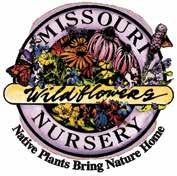
9814 Pleasant Hill Rd Jefferson City MO 65109 www.mowildflowers.net mowldflrs@socket.net 573-496-3492, fax: 573-496-3003
Meet us at one of these locations in St. Louis. Give us your order at least 5 days before a sale, and we will bring it to the location.
Shaw Nature Reserve. Admission fee applies to nonmembers, 307 Pineton Loop Rd, Gray Summit MO 63039. Event: “Shaw Nature Reserve Spring Wildflower Market,” May 3, 9 a.m. to 1 p.m. Member’s only sale Friday, May 2, 3 p.m. to 7 p.m. www. shawnature.org.
Webster Groves City Hall , 4 East Lockwood Ave, Webster Groves MO 63119; Bring Conservation Home Native Plant Sale. May 4 (Sunday), 10 a.m. to 2 p.m.
DAY TRIP! The Nursery is open year round at our Brazito location (address above), 9 to 5 weekdays, and weekends now through July 6, then Aug. 30 through Oct. 12.
At the Nursery only quart pots are $6.95 and small pots are $3.50, if you pick the plants.


Tree outlines her experiences tinkering with the family farm in her book, Wilding: The Return of Nature to a British Farm. Her story is compelling.
Some landowners (farmers) celebrate these changes to tradition that are welcoming wildlife back to the land. These land managers seem to have threaded the needle, conducting ecological restoration while also raising livestock to earn a living. Others, however, are talking (over neatly trimmed hedges) in protest,
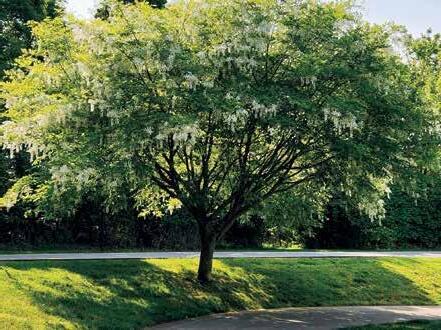


stating that rewilding will lead to reduced food production and undermine farming culture. At this point, few have gone down this path, so I doubt production has waned.
Like rewilding on large properties with Tamworth pigs and Highland cattle in the United Kingdom, wilding with wildflowers on a small scale (at home) in the United States is gaining popularity. Everyday homeowners are rooting out turf in favor of planting native grasses, sedges, and wildflowers. After all, we live in a region once dominated by prairie; what better ecosystem to emulate? Like rewilding a large farm, wilding in suburbia begins by letting go of geometry in favor of the shapes, lines, and contours reflected in nature. It also involves well-made plans, intentional plant choices, and a gardener to keep it from being taken over by trees and invasive plants.
To some people, prairie and other native gardens seem random, chaotic, and unintentional. As if the yard was neglected and forgotten. To be honest, a few are. But most have thoughtful stewards, busy clipping flopping vegetation, tidying meandering pathways, mowing grass borders and removing invasive honeysuckle. They also take breaks on a garden bench to watch bees gather pollen. They gather dandelion greens for soup, plums for jam, and persimmons for pudding. They are intimately involved in the outdoors. Speaking from experience, I and other gardeners I know find ourselves a bit obsessed with the many tasks and wonders that come with tending a wild garden. We endure sore muscles and cracked fingertips because wild gardens give our scattered and unpredictable lives direction and meaning. To those who create and experience a wilded garden, the evidence for why we do it becomes more obvious and compelling as we transform more of it. More native plants mean more butterflies and baby birds; more poppy mallow means more bumblebees; more hummingbirds staking claim on blazing star; more zebra swallowtails on paw paw; more prowling dragonflies and owls circling above; and everything else that is supported by rewarded, native gardens. I’m not opposed to straight lines and rectangles in the garden, it’s when they become barriers that can’t be crossed that bothers me. May your wilding endeavors be as open and fruitful as they possibly can be. Happy gardening y’all!
By Wendell Phillips Berwick
Editor’s note: Galls have been appearing more and more frequently on area trees, leading to many homeowners’ questions about the appropriate treatment or actions to take. Some arborists are advising homeowners to remove the trees. While in some cases, this may be the best and safest way to go, at other times the tree can be saved, or the affliction can be passed off as strictly cosmetic. I asked our arborist friend Wendell Phillips Berwick, owner of Living Tree Care, to provide his input. Here is his response.

Arecent nemesis to the urban forests in our region has hatched their horny little heads; The Gouty Gall and the Horned Oak Gall.
The galls are the result of an infestation of a tiny wasp of the Cynipidae family . The lifecycle is a bit unusual and complicated. It begins with an asexual female that lay eggs on the veins of the oak leaf buds. Sexual male and female wasps emerge from these tiny, blister type galls on the leaf vein about midsummer. Mated females deposit eggs in slits they make on young oak twigs. The next spring swellings on the twigs begin to enlarge, continuing over the next two or three years. The galls provide protection, food, and shelter for the developing larvae. When the larvae reach maturity, the horned galls grow small horns. An adult wasp emerges from each horn and another life cycle of wasps begins.
The Pin oaks learned to live with them for the first few years, and for many oaks, galls are mostly a cosmetic issue. In some cases, the wasps will move on, the galls will eventuall drop off, and that will be it.
Increasing infestations year after year, however, can ‘girdle’ twigs, constricting important transpiration, leading to decline, and in some cases death.
Watering during dry periods and organic fertilizing can help

maintain health and longevity. Prune existing galls to the extent possible. Try to save all pruning for during dormancy. Otherwise trim only deadwood, saving removal of live growth for late summer, fall, and winter pruning.Overwintering may happen in removed twigs, branches, and leaves, so rake and destroy all infested twigs and leaves. Natural predators may also feed on wasps.
These actions may very well keep galls to a strictly cosmetic nuisance level. However, if a certified arborest deems the infestation to be life threatening to the tree, micro injections have recently become available as effective controls. And they do work if administered properly and timely. Consult with a certified arborist, if you feel such procedures may be necessary in your case.
Wendell Phillips Berwick is founder of Living Tree Care, Inc., and is a Tree Surgeon/Arborist/Consultant. You can reach him at 314568-8367.

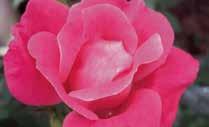



Text and Photos By Samantha Zale
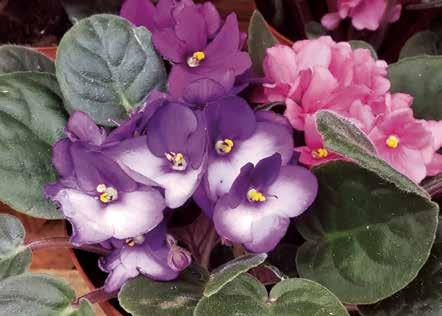
Mother’s Day is the perfect occasion to show your love and appreciation, and what better way to celebrate than with the timeless charm of African violets? These delicate, colorful plants symbolize love and devotion, making them an ideal gift for moms who cherish beauty, warmth and nature.

Here’s how you can make Mother’s Day extra special with these delightful blooms.
Why African Violets?
African violets (Saintpaulia) are beloved for their velvety leaves and clusters of vibrant flowers that come in a spectrum of colors— from deep purples and pinks to whites and even variegated varieties. They’re compact, easy to care for and bloom year-round with the right attention, bringing continuous joy to any space. These plants also hold sentimental value, often passed down through generations, making them a meaningful and enduring gift for Mother’s Day.
Choosing the Perfect African Violet
When selecting an African violet for your mom, consider her preferences and experience with plants. For a beginner, start with a standard variety that’s known for being low maintenance. For seasoned plant lovers, you might explore unique varieties with ruffled or multi-colored blooms. Pair the plant with an attractive decorative or self-watering pot (which is ideal for African violets) to add an extra touch of elegance.
Presenting African Violets as a Gift
Turn your African violet gift into a thoughtful presentation. Place the plant in a self-watering decorative pot. Add a handwritten note with care instructions, including tips for watering, light requirements and feeding. You can even include a small starter kit with a mini watering can, specialized African violet potting mix and fertilizer for ongoing care. For a creative twist, consider arranging multiple African violets in a decorative basket or tray to create a stunning display of colors and textures. This makes for a striking centerpiece that your mom can proudly showcase in her home.







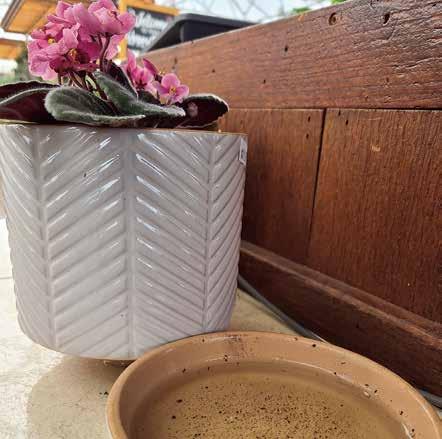
If your mom is new to African violets, share these simple care tips to help her enjoy her plant for years to come:
Light: African violets thrive in bright, indirect light. Place them near an east-facing window or use sheer curtains to filter sunlight. Avoid direct sunlight, which can scorch their leaves.
Watering: Use room temperature water and keep the soil evenly moist but not soggy. Water from the bottom by placing the pot in a


saucer of water, allowing the plant to absorb moisture through its roots. Avoid wetting the leaves to prevent leaf spots or crown rot. Finding a self-watering African violet pot is important for keeping the water away from the crown and leaves of the plant.
Humidity: African violets prefer moderate humidity levels. If the air is dry, place a small tray of water near the plant or group it with other plants to create a microclimate.
Fertilization: Feed African violets with a balanced, water-soluble fertilizer every 4-6 weeks to encourage blooming. Use a formula specifically designed for African violets for the best results.
Repotting: Refresh the soil and repot every 6-12 months using a light, well-draining potting mix designed for African violets. This ensures healthy roots and vibrant blooms.
Make Mother’s Day a memorable event by incorporating African violets into the celebration. Host a brunch or party with a floral theme, using African violets as table centerpieces or party favors. You can also create a family activity by potting violets together, allowing everyone to personalize their plant with unique containers and decorations.
African violets are more than just beautiful plants; they’re a symbol of love, admiration and enduring connection—perfect for honoring the special bond between mother and child. By gifting these elegant blooms, you’re not just giving a plant; you’re offering a living reminder of your appreciation. This Mother’s Day, let African violets be the centerpiece of your celebration and a token of your heartfelt gratitude. Visit your local garden center to check these out. Happy gardening and Happy Mother’s Day to all the mothers!

Text and Photos ByMargy
Terpstra
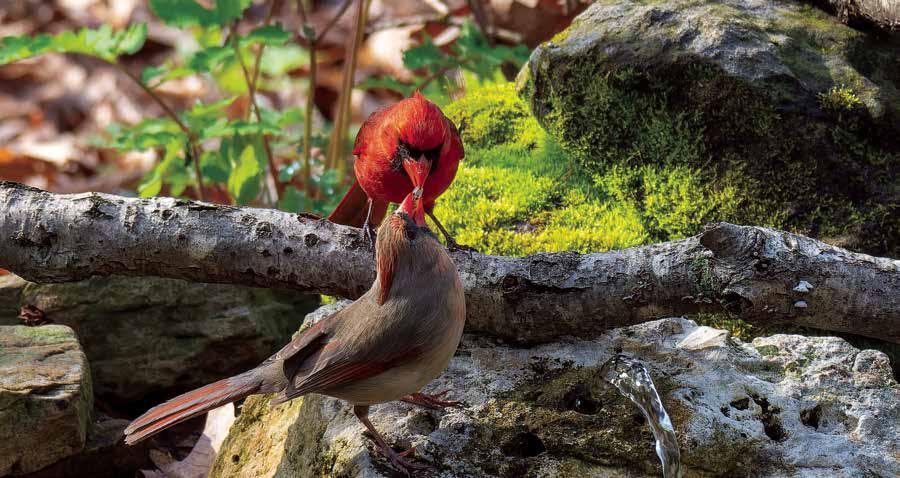
May is a challenging month for resident birds. Enormous amounts of energy have been expended to claim and defend territories, find a mate and gather materials to build nests. Now, many species are busy feeding their young.
They must leave the chicks to look for food and that can be a risky business.
Yards that have good native habitat support chickadees* and tufted titmice. These birds are “indicator species” and their chatter, song and activity attract the attention of migratory birds. All of these birds have evolved with the same native plants that provide the same essential native food, caterpillars!
Caterpillars, primarily of moth species, have all the necessary proteins to build robust baby birds. These caterpillars are also essential to the vitality of the adult birds, both resident and migratory. Survival of any bird depends on its being fit and strong!
Male birds show the promise of fitness and fidelity to their mates in a behavior called, “pair bonding”. They bring food to the female in a display that speaks volumes to their mate. In this way, the female knows it can rely on the male to help find food to raise their nestlings.
In the case of chickadees, a brood of 5-8 chicks require 6,000 to



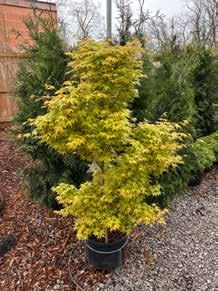


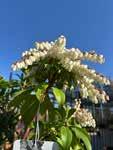
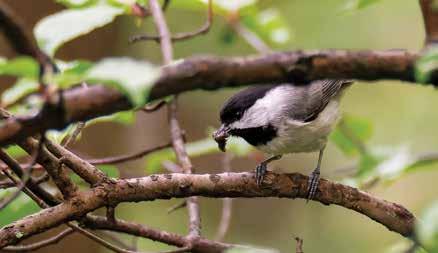


9,000 of these tiny caterpillars! The young birds slowly graduate to small gnats, moths and other larval food. Now, multiply those numbers by additional chickadees, titmice, woodpeckers, thrushes, migratory species, and, oh, my! That’s a lot of caterpillars!
The only way that supply can meet this high demand is with layers of native plant diversity. Work to add native trees, shrubs, wildflowers, ground covers, grasses and ferns into your yard. Be sure to leave the leaves in the fall so that insects may complete their life cycles. This layered diversity supports life, ours and birds as well as butterflies, moths, bees and other beneficial insects. Spiders, beetles, crickets and ants are important secondary fare in this essential insect diet for birds.






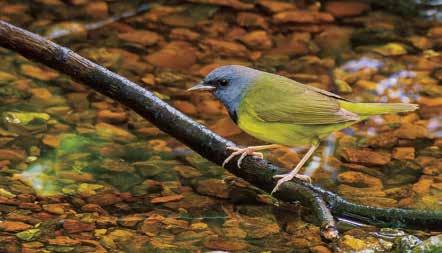
Oh, and be sure not to spray pesticides on any plants in your yard! That defeats the whole purpose of these natural cycles and not only kills the essential insect food, but does harm to the birds. Remember, no insects? No baby birds!
Do check out this information from Cornell Lab on more ways to help birds.https://www.birds.cornell.edu/home/seven-simpleactions-to-help-birds/
There are other changes to consider making in your yard to support birds, bees and pollinators. Reducing lawn area, using less-intensive approaches to lawn management, and expanding native flower beds for example will make birds and pollinators happier.
https://www.xerces.org/blog/no-mow-may-gateway-to-betterlandscape-management-for-bees
Everything we do to restore habitat is also good for us. Not sure what native plants will work for your yard? Check out this website, developed with Dr. Douglas Tallamy to get a personalized list for your zip code. https://nativeplantfinder.nwf.org/




Another vital ingredient to add to healthy habitat is water, because all birds need fresh water for drinking and bathing. An easy to clean bird bath works well. A small water feature with moving water, surrounded by native plants and branches for perching birds may attract even more birds. Our “bubbler” is visited all year by resident and migratory birds with 127 species to date.
May is an exciting month to witness beautiful birds and lots of activity!
*Note: The St. Louis area is in the zone of hybridization for chickadees. Carolina chickadees dominate to our south and blackcapped chickadees live mostly north of the Missouri River, but in this narrow band or zone, which stretches to the east coast, they mate with each other, or hybridize. So, the term “chickadees” is used for the sake of simplicity.
Margy and Dan Terpstra have created a native oasis in the midst of suburban Kirkwood, where they garden with native perennials, trees and shrubs, many selected specifically to attract and nurture the wildlife and songbirds that frequent them. Margy has frequently contributed her articles and photos to The Gateway Gardener, and publishes a blog on her website at hummerhavenunltd.com.
By Ronda Anson, St. Louis Master Gardener
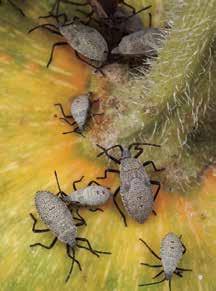
Squash bugs gathering on a pumpkin.

Too often squash bugs are blamed for the damage caused by squash vine borers or by bacterial wilt. Squash bugs, a kind of leaf-footed bug, are easy to see. They seem to love company. It’s as if a bug rock festival has landed on your squash plants. Squash bugs of all ages mass together in feeding frenzy on your plants, literally sucking the life out of the leaves, while the adults engage in free love and drop red-orange football-shaped eggs to create yet more bugs to join the party. They will suck the juice of the squash leaves until the leaves wilt and dry out. But what they don’t do is make the plant suddenly collapse and die. That is usually caused by a hidden enemy: squash vine borers. The adult borer is a clear wing moth that looks more like a wasp than a moth. The female usually lays her tiny little eggs on the stem of a squash plant or a pumpkin or melon or gourd. When the eggs hatch, tiny little caterpillars chew their way into the stems and vines of your plant. And those babies are ravenous. By the time they are ready to pupate (just as butterflies do), the stems and vines of your plants are just hollow tubes that collapse under their own weight. The caterpillars are a good example of the old adage: you are what you eat. They are typically the color of their food, the pith of the squash plant -- a creamy white, and hard to distinguish from the pith. When they have ended their feast, the vines appear to have exploded from the inside out with globs of yellowishwhite frass (a combination of bug poop and plant debris).
There is very little you can do about either squash bugs or squash vine borers or bacterial wilt. Chemical pesticides are of little use, since cucurbits (squash, pumpkins, melons, cucumbers, and gourds) have separate male and female flowers, which require insects, usually bees, to move the pollen from the male flower to the female. Without that there will be no fruit, and poor or partial pollination means distorted or malformed fruit. So, it’s best to keep the pesticides away from the cucurbits.
If you need someone to commiserate with or someone to discuss your options (there are a few), give us a call at the MU Extension St. Louis Master Gardener Hotline (314-400-7657)
or come by to see us at 9667 Page Avenue. You can also email us your questions or send us pictures of your plant problems: StlGardenHotline@gmail.com.
Ronda Anson is certified as both an Illinois and Missouri Master Gardener. She wa a longtime Horticulture Answer Service and Plant Dr. volunteer at Missouri Botanical Garden and continues to teach Insect ID classes to master gardeners and the general public. She helped set up the gardeening answer service for MU Extension-St. Louis County where visitors, callers and emailers and their questions are welcome. See contact information above.
By Robert Weaver
If you have squash vine borers, then, left alone, your vines are going to shrivel and die. So with that prognosis, here’s a way to give your plants a fighting chance!
1: Scout your cucurbit vines early and often. The minute you see signs of squash vine borer damage (see Ronda’s descriiption and the photo here) is the time to act! Don’t wait for the vine to totally collapse! Look for the damage on the vine!

2. Using a VERY sharp knife or razor blade, make a 2-3” slit in the vine, in the same direction as the vine’s growth, just above the damaged area,
3. Carefully pry the vine open. With any luck, you’ll immediately see the offending larvae (As Ronda said, it’s the same color as the pith, but will usually be squiggling a bit.)
4. Once you’ve found the bugger, act quickly as it will be heading north up the vine trying to escape. Dig it out with your knife blade, and feed it to a grateful nearby bird (birds absent, squash the squash borer!).

5. Place the vine down in contact with the ground, and cover the damaged area with an inch or two of compost or garden soil. With any luck at all, the vine will put out new roots, and the plant will live to produce a bountiful crop of pumpkins, squash or whatever cucurbit you’re growing.
The Garden Tours are coming soon! Here are the ones we’ve been notified of as of our deadline, providing plenty of opportunities to check out the area’s most interesting gardens and gather some tips to implement in your own landscape!
May 4thth 9am-4pm
St. Louis Native Plant Garden Tour.


The popular St. Louis Native Plant Garden Tour is produced annually by St. Louis Audubon Society and Wild Ones St. Louis Chapter. This year, 10 gardens are in and around Webster Groves.
This self-guided tour includes a wide variety of habitats, native landscaping styles and yard sizes. This is an educational tour, so there will be a lot of information posted in gardens and shared by the homeowners and by volunteer docents throughout the day. To register go to stlouisaudubon.org.
May 17th-18th
Tour10am-4pm both days. Sale Sat., 9am-4pm Sun. 10 until supplies last
Ste. Genevieve Master Gardener
Spring Garden Walk and Plant Sale.


The Ste. Genevieve Master Gardeners and Missouri University Extension Spring Garden Walk and Plant Sale features tours of private and historic gardens and a Plant Sale with a variety of plants for sale that includes annuals, perennials, natives, vegetables, houseplants and Lily Bulbs, the Ste. Genevieve’s honorary flower. Enjoy shopping, lunch. Explore the local nature areas and wineries. Walk begins at the Ste. Genevieve National Historic Landmark District Welcome Center at 66 South Main St. Contact University of Missouri Extension at (573) 883-7097 or VisitSteGen.com. Proceeds benefit the Ste. Genevieve Master Gardeners Beautification Grant program.
June1st – 2nd 10am
30th Annual Town and Country Garden Tour

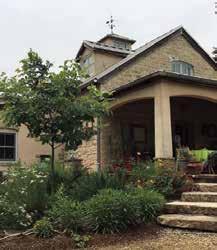
The Garden Tour includes both a walking tour of gardens in downtown Historic Hermann and a driving tour to gardens in the hills around Hermann. The $20 ticket price includes visits to at least five private gardens; Town gardens include a traditional four-square garden, a distiller’s garden, a native plant cottage
garden, a coffee lover’s retreat, and a large garden with lily and iris collections. Country gardens include an artists’ garden with a blooming prairie, an historic home with unique plantings and a native prairie, and a very large country garden with greenhouses and raised beds. Garden Tour visits may be spread over Saturday and Sunday. Tickets will be sold online before the tour at Eventeny and at Topiaries (138 E. 4th) in downtown Hermann during the tour from 10-4 on Saturday and 10-3 on Sunday. Gardens close at 5PM on Saturday and 4PM on Sunday. A map to the gardens will be provided starting on Saturday June 7th at 10am at the Topiaries ticket sale site; those who pre-purchase tickets will pick up the map at that time as well. The Hermann Garden Club’s website www.hermanngardentours.com provides up-to-date events, ticket prices, links to the online ticket sale site, contact numbers, and photographs of past tour gardens. Visit the FAQS page on the website for answers to all your questions. “Like” us on Facebook at “Hermann Garden Tours.”
June 7th
10am-4pm
Garden Vignettes: East Central District Garden Tour
Visit your choice of 10 ECD members’ gardens. Gardens are located in Webster Groves, Sunset Hills, Town and Country, Fenton, Oakville and Mehlville. To purchase tickets, email Jackie Reynolds at: jreynolds452@charter.net. $20/ea.
June 13th-14th
4-8pm Fri., 9am-1pm Sun Secret Garden Tour 2025

There will be 6 lovely gardens available for viewing. Tickets $10 ea., children free. Available during tour hours at Lebanon Visitor’s Center, 221 W. St. Louis St., Lebanon, Il. 62254. More info at.gardencluboflebanon.org., or follow on Facebook.
June 21st-22nd
9am-5pm
Pond-O-Rama 25th Anniversary Water Garden Tour
The St. Louis Water Garden Society (SLWGS) celebrates 35 years bringing water garden enthusiasts together for education, community service, and resource sharing. The 2025 tour will feature 28 private water gardens owned and maintained by Society members, with each day featuring different gardens. This

self-guided tour highlights water gardens located throughout the St. Louis metropolitan area, arranged each day by geographic location, including many new and upgraded gardens, ponds and waterfalls. The full color ticket booklet contains host garden pictures, descriptions of the water features, directions, accessibility, and a QR code to each location.
Showcasing a wide variety of water gardens from new to well established, intimate spaces to whole yards, and featuring bridges, gazebos, koi and goldfish, waterfalls, statues, bubblers, and much more, our hosts are eager to share their gardens and expertise with the public. Many hosts are Master Gardeners, Audubon Society (Bring Conservation Home) certified native landscapes, have been featured in St. Louis Homes and Lifestyle magazine, and/or featured in local newspapers and magazines.
Tickets covering both days of the tour are $25 each (18 and older) and will be available beginning in May at local retail shops and garden centers throughout the metropolitan area or on our website (https://slwgs.org). A special 2025 Discount: Groups of 5 or more are only $20 each. Please see the SLWGS website for more information.
This year we are highlighting our civic project, the planting and maintaining of the elegant and serene lily ponds at the Jewel Box in Forest Park. The St Louis Water Garden Society’s members work weekly from May to October to make the lily ponds gorgeous for the visitors who come to Forest Park. Our civic project is funded by our Pond-O-Rama tour each year.
June 22nd
Noon-4pm
New Town Garden Club Annual Garden Tour

Text
Photos by Robert Weaver

When I was growing up my family vacationed every summer at a cottage on Lake Michigan adjacent to a cottage my uncle owned. One of my fondest memories were of the hummingbirds that were constantly attending the feeder outside the large picture window that looked out over the Lake at my uncle’s place. I never saw hummingbirds in St. Louis, as my parents didn’t put out feeders, and the hostas and English ivy that dominated our landscape were of no interest to them. So I assumed they, along with chipmunks and daddy longlegs, were a Michigan thing.
It wasn’t until I started gardening as an adult that I discovered that there were indeed hummers in St. Louis, and if you “built it” they would come. (I’ve also discovered, with much less delight, that chipmunks are a St. Louis thing as well.) And so, as my gardening style has evolved over the last 30-40 years, my focus has become much less about what plants look like, and much more about who they feed and provide shelter for. And—in addition to pollinators and insects and birds—high on my list of desired visitors are hummingbirds.
From spring to fall, here are a few of my favorite hummingbirdattracting native plants (mostly) from my garden.
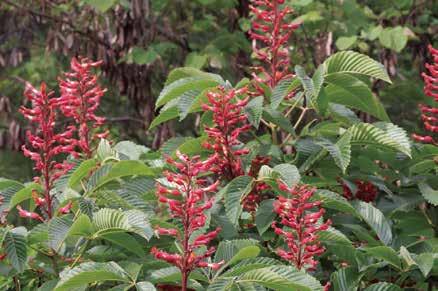
I clump these two together because they both are considered “indicator plants”—flags that, when you see them blooming, alert you it’s time to get the hummingbird feeders out!.
Red Buckeye (Aesculus pavia) is a medium-sized (woody guru Michael Dirr calls it small) shrub that can easily reach 20’ or more in size and width. The shrub is handsome in its own right, but included here because of the 6-8” red panicle flowers it sends out in April to greet the earliest arriving hummers. There are many cultivars that provide variations in shrub size, flower vibrancy, and other differences; I’m happy with the Missouri native straight species.
Columbine (Aquilegia canadensis) is a Missouri native perennial that sends out trumpeted red and yellow flowers in late April, again announcing the incoming scouts and early-arriving hummingbirds. Columbine likes well drained, even rocky soils and will colonize such areas. In my deep-soiled garden, I have a hard time keeping it established. Not so with its cousin, purple and white Alpine columbine, which was established in my garden when I moved in and happily seeds everywhere.

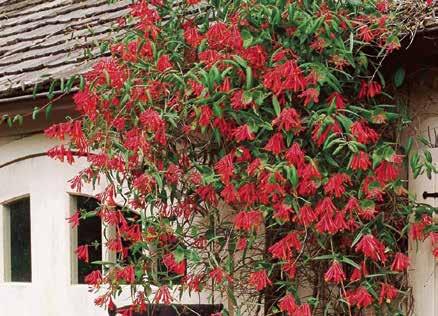
Coral honeysuckle (Lonicera sempervirens) might be my favorite, though it’s more aspirational than a reality at this time. (The photo above is not from my garden, I’m sad to say.) I love it in other people’s gardens, and have tried for several years to get it established in my own, but clumsy gardening has brought early attempts to a premature demise (weeding out aggressive autumn clematis in the same area, and..whoops!). But the latest effort, a gift of the ‘Major Wheeler’ cultivar, bloomed enough last summer to offer a brief glimpse of a hummer visit, and promise for the future. Unlike trumpet vine (Campsis radicans), another midsummer hummer favorite, coral honeysuckle is a wellbehaved vine and won’t take over the garden.
Indian Pink (Spigelia marilandica) puts out tubular red flowers with yellow throats that hummingbirds are drawn to in early
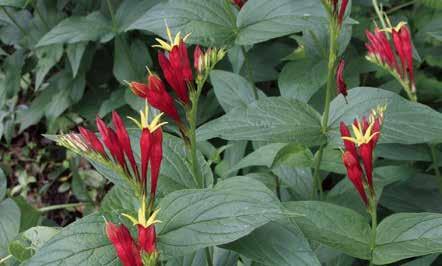
summer. Grows well in part shade, average to moist soils).
Cardinal flower
Full Disclosure: The cardinal flower (Lobelia cardinalis) in the banner photo on the adjacent page isn’t mine; it’s my neighbors, growing in her side garden adjacent to our side yard. But the small space of our combined side yards enables me to sit on my property while taking pictures of hummers at her flowers. That counts, right?
Cardinal flower is, in my opinion, the top dog of hummingbird magnets. I never have to sit more than a few minutes before a hummingbird flies in and starts methodically flitting from flower to flower. The bright red color and trumpet shaped blooms
are textbook qualifications for a hummer-magnet flower. It’s described as a short-lived perennial, but give it moist/wet soil and it will reseed with vigor, as it does in my neighbor’s beautiful garden. Good enough for me.
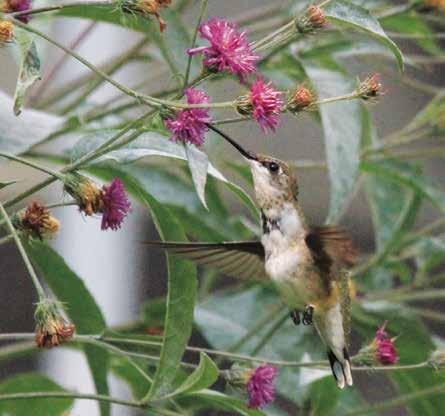
I have lots of fall-blooming natives that are wonderful pollinator attractors, but none that I can really say make a name for themselves with the hummers. Iron weed (Vernonia spp.) might do its part, and popular fall natives like asters and goldenrod get mentioned as hummingbird attractors. A visit to my photo files reminds me that I actually have photos at fall bloomers. My memory though, is mostly of the birds at the syrup feeders in the fall, or (if I happened to have planted any) among the annual salvias (especially Mexican sage or blue salvia). In the herb garden Anise hyssop was once a popular stopping off point, but it’s been some years since it last grew on my grounds. And that’s my year of trying to keep the (hummingbird) customers satisfied.Off in the corner of my yard as I write, I see the bright flags of red buckeye starting to form. Time to get the feeders out.


Updates to this information are often posted on our online events calendar at www. GatewayGardener.com, so check there for the latest details.
Give us the details of your upcoming gardening, lawn or landscaping event and we’ll add it to our website and include it in our next issue. Deadline for printing in the September issue is August 1st.
How to reach us: Mail: PO Box 220853, St. Louis, MO 63122 Email: info@gatewaygardener. com
May 3rd
9am-Children’s Garden Club. Planter with Annuals and Planting the Garden. FREE. Pre-registration is required on the St. Louis County website at https://tinyurl.com/yc3v3pfj or by calling 314-615-4386. Sponsored by St. Louis County Parks Department. Queeny Park – CGC Nursery, 1675 S. Mason Rd. (Queeny Park East Entrance), St. Louis 63131.
June 7th
9am—Children’s Garden Club. Wind Chimes. FREE. Queeny Park – CGC Nursery, 1675 S. Mason Rd. (Queeny Park East Entrance), St. Louis 63131. FREE. Pre-registration is required on the St. Louis County website at https:// tinyurl.com/yc3v3pfj or by
calling 314-615-4386.
May 1st
6pm—Spring Fashion Show
Passiglia Landscape, Nursery & Garden Center, 1855 MO-109, Wildwood, MO 63038. (636) 458-9202, passiglia@passiglia. com. Passiglia.com.
May 2nd-3rd
Fri. Noon-8pm, Sat. 9am5pm—The Gardeners of Florissant Annual Spring Plant Sale and Garden Bazaar. Perennials, annuals, shrubs, shade plants, vegetables, herbs, hanging baskets and more! Indoors and climate controlled for your comfort. Easy loading from multiple doors. NEW LOCATION! Florissant Elks Lodge 16400 New Halls Ferry Rd., Florissant, MO 63031.
May 2nd-3rd
3-7pm Fri. (members only), 9am-1pm Sat.—Spring Wildflower Market. Shop from a wide selection of Missouri native wildflowers, grasses, shrubs, vines, sedges and trees suitable for all conditions and grown by local nurseries in the region. Talk to native plant experts and enjoy beer, wine, spirits, cheese, honey, crafts and more. Shaw Nature Reserve, 307 Pineton Loop Rd., Gray Summit, MO.
May 2nd-3rd
Fri., 2-7pm, Sat.7am -noon— O’Fallon (MO) Garden Club Plant Sale /Rummage Sale Native plants and perennials from member’s gardens. Also, gently used gardening items, books and tools. Experienced gardeners will be available. There will also be gently used/ clean household items. 46
Spangle Way Dr. , O’Fallon, MO 63366.
May 3rd
8am-4pm—Central Missouri Master Gardeners Plant Sale. Tomatoes, peppers and hanging baskets grown in CMMG greenhouses by master gardeners. Also perennials and natives donated by members for sale. Prices vary starting from $4. Three greenhouses full of tomatoes, annuals, vegetables and herbs. 810 Sandstone, North Jefferson City (by the dog park). Service dogs welcome, but please leave other pets at home.
May 3rd
8:30am-noon—Webster Groves Women’s Garden Association Plant Sale. Hundreds of homegrown sun and shade perennials from Webster Groves Women’s Garden Association gardens, plus small container arrangements ready just in time for Mother’s Day. Stop by for plants AND expertise from our master gardeners. Cash, check, debit or credit. Rain or shine, we’ll be there to help you with your spring planting needs. Profits go to support horticultural programs at WG schools and other community projects. parking lot of WG First Congregational Church located at Elm and Lockwood.
May 3rd-4th
7am-3pm Sat, 9am-4pm Sun— Kress Farm Garden Preserve Plant Sale. We will have a large selection of native plants propagated at Kress Farm and many varieties of perennials, annuals, herbs, vegetables, trees, shrubs and more. Master Gardeners will be on hand to answer your questions. Located a short drive from St. Louis at 5137 Glade Chapel, Hillsboro,
Mo. 63050. Call 314-750-6490 for more info.
May 4th
10am-2pm—Bring Conservation Home Native Plant Sale. Webster Groves City Hall, 4 East Lockwood, 63119.
May 4th
9am-4pm—St. Louis Native Plant Garden Tour. See details on page 18-19.
May 5th-June 16th (Mondays)
9:30-Noon—Master Pollinator Steward Course. Help protect our bees, birds, and butterflies essential to our environment and food sources. Topics include Insects, Plant-pollinator interactions, Honeybees, Native Bees and Other Pollinators, Pollinators in Nature, Pollinators in Agriculture. Sessions are held virtually or in person at MU Extension Urban East Regional Office, 8225 Florissant Rd., St. Louis, Missouri 63121. Register at http://muext.us/MPSSL or all 314-403-7410
May 10th
9am-noon—Longview Farm Park Plant Sale. Plants are collected from the gardens at the park and members’ gardens. Deer resistant perennials and native plants available. Cash or checks only. All proceeds benefit the Longview gardens and St. Louis charities. 13525 Clayton Rd., Town and Country 63131.
May10th
10am-3pm—Mother’s Day Porch Pot. Drop by the nursery anytime between 10 and 3 to create a special Mother’s Day Porch Pot, enjoy refreshments and a free gift. Fee: $55, payable at the front desk when you arrive. Passiglia Landscape, Nursery & Garden Center,
1855 MO-109, Wildwood, MO 63038. (636) 458-9202, passiglia@passiglia.com. Passiglia.com.
May 10th
10am-5pm—Washington County in Bloom Flower Festival. Seed and plant swap. Craft and Plant booths, expert speakers presenting workshops, food trucks and more. Forshana Farm, 16270 W. State Highway 8, Potosi, MO. Visit WashCoFlowerFestival.com for more info.
May 10th
9am-noon—Kirkwood Garden Club Plant Sale. Featuring a variety of native plants, perennials and potted plants. Ken Conner Park, corner of S. Kirkwood Rd. and Argonne, Kirkwood, MO.
May 11th
8am-Noon—Mississippi Valley Garden Club Plant Sale. Plants divided from members gardens. Mostly perennials, native plants some seedlings and veggies. Experienced gardener on site. Also, gently used tools, books, etc. AltonWood River Sportsmen’s Club, 3109 Godfrey Rd., Godfrey, IL 62035.
May 11th
Noon-5pm—Iris Flower Show. Beautiful Iris self-guided flower show indoors. Many varieties of stunning and charming irises to see. Hosted by Greater St. Louis Iris Society/ AIS. Free to attend with paid admission to the Garden. Missouri Botanical Garden, 4344 Shaw Blvd., St. Louis.
May 17th
10am-3pm—Plant America Garden Expo. Weldon Spring Interpretive Center, 7295 S. Highway 94, St. Charles, 63304. Sponsored by 3 garden clubs and a sustainability organization. Free fun-filled day, vendors, demonstrations, education, knowledgeable
speakers, food trucks, lots of free kids’ activities and lots of other activities.
May 17th
9am-5pm—67th Annual African Violet Show & Sale. “75 Years of African Violets Diamond Jubilee.” Presented by the Metropolitan St. Louis African Violet Council. Horticulture-Design exhibits, educational info and supplies. African violets and other gesneriads. Area growers will be on hand to give plant care advice and share information about this organization. Open to the public and free with Garden admission. Missouri Botanical Garden, 4344 Shaw Blvd., St. Louis 63110.
May 17th-18th
9am-4pm Sat., 10am-4pm Sun.—Ste. Genevieve Master Spring Garden Walk and Plant Sale. See details on page 18-19.
May 24th
10am—Walk in the Garden. Start your day by reducing stress, improving your mood, getting physical activity and enjoying the sights and smells of the Garden. Passiglia Landscape, Nursery & Garden Center, 1855 MO-109, Wildwood, MO 63038. (636) 458-9202, passiglia@passiglia. com. Passiglia.com.
June 1st & 2nd
10am—29th Annual Town and Country Garden Tour. See details on page 18-19.
June 7th
10am-4pm—Garden Vignettes. East Central District Garden Tour. See pgs. 18-19 for details.
For more June Garden Tours, please see pages 18-19.






